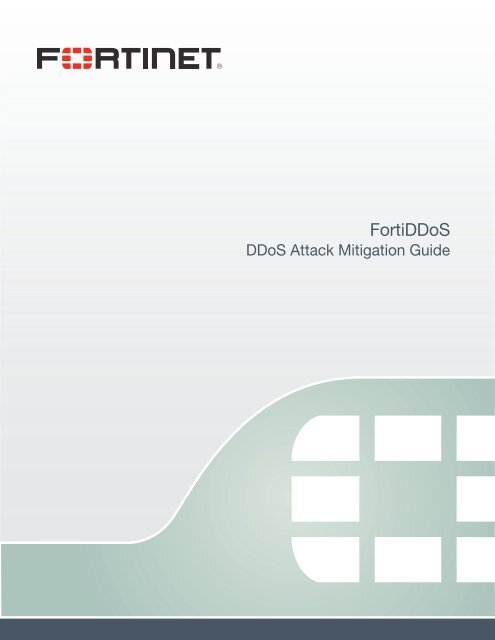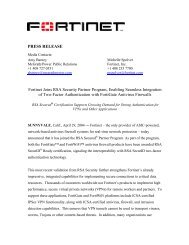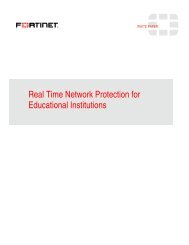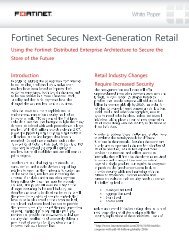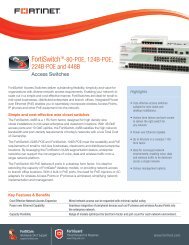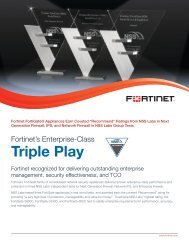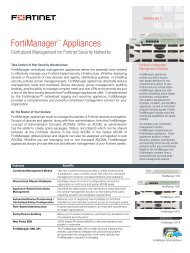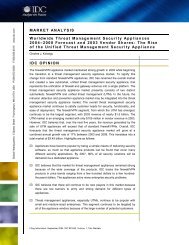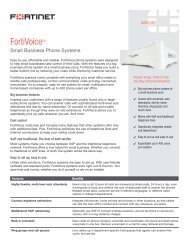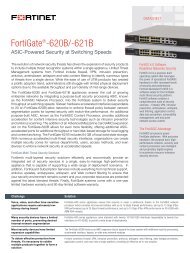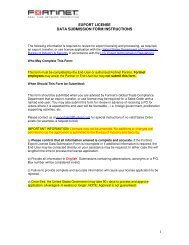FortiDDos DDoS Attack Mitigation Guide - Fortinet
FortiDDos DDoS Attack Mitigation Guide - Fortinet
FortiDDos DDoS Attack Mitigation Guide - Fortinet
You also want an ePaper? Increase the reach of your titles
YUMPU automatically turns print PDFs into web optimized ePapers that Google loves.
Forti<strong>DDoS</strong><br />
<strong>DDoS</strong> <strong>Attack</strong> <strong>Mitigation</strong> <strong>Guide</strong>
May 1, 2012<br />
28-100-167076-20120501<br />
Copyright© 2012 <strong>Fortinet</strong>, Inc. All rights reserved. <strong>Fortinet</strong>®, FortiGate®, and<br />
FortiGuard®, are registered trademarks of <strong>Fortinet</strong>, Inc., and other <strong>Fortinet</strong> names herein<br />
may also be trademarks of <strong>Fortinet</strong>. All other product or company names may be<br />
trademarks of their respective owners. Performance metrics contained herein were<br />
attained in internal lab tests under ideal conditions, and performance may vary. Network<br />
variables, different network environments and other conditions may affect performance<br />
results. Nothing herein represents any binding commitment by <strong>Fortinet</strong>, and <strong>Fortinet</strong><br />
disclaims all warranties, whether express or implied, except to the extent <strong>Fortinet</strong> enters<br />
a binding written contract, signed by <strong>Fortinet</strong>’s General Counsel, with a purchaser that<br />
expressly warrants that the identified product will perform according to the performance<br />
metrics herein. For absolute clarity, any such warranty will be limited to performance in<br />
the same ideal conditions as in <strong>Fortinet</strong>’s internal lab tests. <strong>Fortinet</strong> disclaims in full any<br />
guarantees. <strong>Fortinet</strong> reserves the right to change, modify, transfer, or otherwise revise this<br />
publication without notice, and the most current version of the publication shall be<br />
applicable.<br />
Technical Documentation: docs.fortinet.com<br />
Knowledge Base: kb.fortinet.com<br />
Customer Service & Support: support.fortinet.com<br />
Training Services: training.fortinet.com
Table of Contents<br />
Introduction.............................................................................................. 1<br />
Defining <strong>DDoS</strong> attacks...................................................................................... 1<br />
<strong>Attack</strong> scenarios ............................................................................................... 1<br />
Causes of attacks ............................................................................................. 1<br />
Motivation behind attacks ................................................................................ 2<br />
Virus infections, botnets and distributed attack tools ...................................... 2<br />
Most common current generation <strong>DDoS</strong> attacks ............................................. 4<br />
SYN flood.................................................................................................... 4<br />
Zombie flood............................................................................................... 4<br />
ICMP flood.................................................................................................. 4<br />
TCP/UDP port flood.................................................................................... 4<br />
Fragment flood............................................................................................ 5<br />
Anomalous packet flood............................................................................. 5<br />
HTTP GET flood.......................................................................................... 5<br />
Blended attacks.......................................................................................... 5<br />
Floods from unwanted geographical areas ................................................ 5<br />
Myths and realities about <strong>DDoS</strong> attacks .......................................................... 5<br />
Home remedies for simple and small <strong>DDoS</strong> attacks ........................................ 6<br />
Anti-<strong>DDoS</strong> appliances ...................................................................................... 7<br />
Carrier <strong>DDoS</strong> mitigation solutions .............................................................. 7<br />
Custom logic (FPGA or ASIC) based internet data center (IDC), web hosting<br />
and web property <strong>DDoS</strong> mitigation solutions............................................. 7<br />
Software based web property <strong>DDoS</strong> mitigation solutions.......................... 8<br />
Things to look for in Anti-<strong>DDoS</strong> equipment...................................................... 8<br />
Latest technology ....................................................................................... 8<br />
Centralized monitoring................................................................................ 8<br />
Visibility into normal network traffic patterns.............................................. 8<br />
Alerting mechanisms .................................................................................. 8<br />
Filtering mechanisms to reduce false positives.......................................... 8<br />
Low latency................................................................................................. 8<br />
Hardware logic for Anti-<strong>DDoS</strong> .................................................................... 9<br />
Bypass and redundancy ............................................................................. 9<br />
Extensible architecture ............................................................................... 9<br />
Forti<strong>DDoS</strong> <strong>DDoS</strong> <strong>Attack</strong> <strong>Mitigation</strong> <strong>Guide</strong><br />
28-100-167076-20120501 iii<br />
http://docs.fortinet.com/ • Feedback
<strong>DDoS</strong> <strong>Attack</strong> Trends in 2012................................................................. 10<br />
SYN Floods will continue to grow................................................................... 10<br />
Concurrent connection-based attacks will be on the rise.............................. 10<br />
Botnet floods will be rising ............................................................................. 10<br />
Support for IPv6 will become important......................................................... 11<br />
Social network attacks will be common ......................................................... 11<br />
Cyber Warfare will start to take shape............................................................ 11<br />
Collateral damages in multi-tenant environment will grow............................. 11<br />
Hosted clouds may kick you out under attack to avoid collateral damage.... 11<br />
Conclusion...................................................................................................... 11<br />
<strong>DDoS</strong> <strong>Mitigation</strong> Techniques ................................................................ 12<br />
Introduction..................................................................................................... 12<br />
SYN proxy....................................................................................................... 12<br />
Connection limiting......................................................................................... 12<br />
Aggressive aging ............................................................................................ 12<br />
Source rate limiting......................................................................................... 13<br />
Dynamic filtering ............................................................................................. 13<br />
Active verification through legitimate IP address matching ........................... 13<br />
Anomaly recognition....................................................................................... 13<br />
Protocol analysis ............................................................................................ 13<br />
Granular rate limiting ...................................................................................... 14<br />
White-list, black-list, non-tracked sources..................................................... 14<br />
State anomaly recognition.............................................................................. 14<br />
Stealth attack filtering ..................................................................................... 14<br />
Dark address scan prevention........................................................................ 14<br />
Botnet <strong>Attack</strong> <strong>Mitigation</strong> ....................................................................... 15<br />
Overview of botnet attacks............................................................................. 15<br />
Distributed denial of service attacks using botnets........................................ 15<br />
A typical botnet launch pad............................................................................ 16<br />
What's common among the botnet attack packets ....................................... 16<br />
Can you do the same processing in CPU based systems? ........................... 17<br />
Blocking botnet attack packets using Forti<strong>DDoS</strong> appliances ........................ 17<br />
Conclusion...................................................................................................... 17<br />
Deploying a Solution.............................................................................. 18<br />
Introduction..................................................................................................... 18<br />
A very simple deployment .............................................................................. 18<br />
Dual WAN link deployment with a single appliance ....................................... 20<br />
Typical deployment for an internet data center with two links protected by two<br />
independent devices in active configuration .................................................. 21<br />
Typical deployment for an internet data center with two links protected by two<br />
Forti<strong>DDoS</strong> <strong>DDoS</strong> <strong>Attack</strong> <strong>Mitigation</strong> <strong>Guide</strong><br />
28-100-167076-20120501 iv<br />
http://docs.fortinet.com/ • Feedback
independent devices ...................................................................................... 22<br />
<strong>DDoS</strong> and SaaS Model for E-Commerce............................................. 23<br />
Impact of third party dependence on your business...................................... 23<br />
Use of third party services in eCommerce ..................................................... 23<br />
The issue with third party dependence on infrastructure ............................... 24<br />
Conclusion...................................................................................................... 24<br />
Testing a <strong>Mitigation</strong> System ................................................................. 25<br />
Introduction..................................................................................................... 25<br />
Typical test benches....................................................................................... 25<br />
<strong>DDoS</strong> attack test conditions - a broad classification ..................................... 26<br />
Spoofed floods vs. non-spoofed floods ................................................... 26<br />
Anomalous header floods......................................................................... 26<br />
Anomalous state floods ............................................................................ 27<br />
Limited sources versus large number of sources floods.......................... 27<br />
Layer 3, 4 or 7 <strong>DDoS</strong> attack...................................................................... 27<br />
Random header parameter attack............................................................ 27<br />
Blended attack.......................................................................................... 27<br />
<strong>Attack</strong>s to test functionality and performance................................................ 27<br />
Spoofed syn flood attack.......................................................................... 27<br />
Spoofed UDP attack................................................................................. 28<br />
Spoofed ICMP attack ............................................................................... 28<br />
Spoofed TCP SYN-ACK attack ................................................................ 28<br />
Spoofed TCP FIN-ACK attack .................................................................. 28<br />
Spoofed IP attack ..................................................................................... 28<br />
Spoofed IP fragments attack.................................................................... 28<br />
IP-UDP fragments attack.......................................................................... 28<br />
IP-ICMP fragments attack ........................................................................ 28<br />
TCP/UDP destination port attack ............................................................. 28<br />
Spoofed TCP-SYN / UDP / ICMP blended attack.................................... 29<br />
Non-spoofed TCP SYN-ACK.................................................................... 29<br />
Non-spoofed TCP SYN attack.................................................................. 29<br />
Non-spoofed TCP FIN-ACK attack........................................................... 29<br />
Non-spoofed TCP ACK attack.................................................................. 29<br />
HTTP half-connection attack .................................................................... 29<br />
Non-spoofed UDP attack ......................................................................... 29<br />
Non-spoofed DNS attack ......................................................................... 29<br />
Non-spoofed ICMP attack........................................................................ 30<br />
Non-spoofed TCP ACK flood ................................................................... 30<br />
Spoofed TCP ACK flood........................................................................... 30<br />
Non-spoofed TCP NULL flood ................................................................. 30<br />
Spoofed TCP NULL flood ......................................................................... 30<br />
Non-spoofed TCP random flag flood ....................................................... 30<br />
Spoofed TCP random flag flood............................................................... 30<br />
Forti<strong>DDoS</strong> <strong>DDoS</strong> <strong>Attack</strong> <strong>Mitigation</strong> <strong>Guide</strong><br />
28-100-167076-20120501 v<br />
http://docs.fortinet.com/ • Feedback
TCP random sequence, acknowledgement numbers .............................. 30<br />
TCP random window size......................................................................... 31<br />
TCP random option value ......................................................................... 31<br />
TCP random data length........................................................................... 31<br />
TCP checksum error flood........................................................................ 31<br />
IP random identification flood................................................................... 31<br />
IP random fragment flag, offset flood....................................................... 32<br />
IP random TTL flood ................................................................................. 32<br />
IP random protocol ................................................................................... 32<br />
UDP checksum error ................................................................................ 32<br />
Non-spoofed ICMP echo reply flood........................................................ 32<br />
Spoofed ICMP echo reply......................................................................... 32<br />
Un-spoofed ICMP type/code flooding...................................................... 32<br />
Spoofed ICMP random type/code flooding.............................................. 33<br />
Non-IP flooding......................................................................................... 33<br />
Conclusion...................................................................................................... 33<br />
Choosing a <strong>DDoS</strong> <strong>Mitigation</strong> System................................................... 34<br />
Introduction..................................................................................................... 34<br />
Hardware logic or software appliance............................................................ 34<br />
Customization................................................................................................. 34<br />
Virtual partitioning and multiple policies......................................................... 35<br />
Bidirectional attack mitigation ........................................................................ 35<br />
Connectivity.................................................................................................... 35<br />
Legacy <strong>DDoS</strong> attack mitigation systems........................................................ 35<br />
Network layer and application layer attacks................................................... 35<br />
Hardware redundancy .................................................................................... 36<br />
Centralized monitoring, alerts and reports ..................................................... 36<br />
Performance and capacity.............................................................................. 36<br />
Openness in specifications............................................................................ 36<br />
Field upgrades ................................................................................................ 36<br />
Role based management and audit trails....................................................... 37<br />
Performance and reputed third party validation............................................. 37<br />
Post sales support.......................................................................................... 37<br />
Customer reference is the best validation ...................................................... 37<br />
A sample matrix for solution comparison ....................................................... 37<br />
Conclusion...................................................................................................... 39<br />
Forti<strong>DDoS</strong> <strong>DDoS</strong> <strong>Attack</strong> <strong>Mitigation</strong> <strong>Guide</strong><br />
28-100-167076-20120501 vi<br />
http://docs.fortinet.com/ • Feedback
Introduction<br />
Defining <strong>DDoS</strong> attacks<br />
<strong>Attack</strong> scenarios<br />
Causes of attacks<br />
Denial of service (DoS) attacks are attacks that are deliberate attacks on your network<br />
properties to deny service to legitimate users. When these attacks seemingly come<br />
from distributed sources, they become distributed denial of service (<strong>DDoS</strong>) attacks.<br />
A few years back, it was common to use spoofing techniques where a hacker would<br />
actually use very few machines (or just one machine) and spoof multiple IP addresses.<br />
To the attacked destination it would seem that the attack is coming from multiple IP<br />
addresses. However in the recent times, with the advent of infected PCs, increasing<br />
number of smart mobile phones, many botnets are available around the world, which<br />
can be used to launch a real <strong>DDoS</strong> attack.<br />
• Under attack, your team does not know details of the attack. They understand the<br />
symptoms, but they can’t figure out the cause and the solution.<br />
• Your routers and switches are overloaded and they don’t have the capability to stop<br />
such attacks. Firewalls simply allow these packets. IPS appliances (if you have<br />
them), don’t have the rules to block such attacks. Your equipment doesn’t match up<br />
in performance that’s required.<br />
• May be, you have multiple links to the Internet. The attackers are attacking from<br />
different links.<br />
• The attack is seemingly coming from all over the world. You cannot simply identify a<br />
Net-block to deny so that the attack can be stopped! And you cannot simply block<br />
everyone!<br />
• The attack is no different from legitimate users accessing your web pages from the<br />
point of your edge equipment.<br />
• Your team is unable to figure out the solutions quickly when the attackers are<br />
constantly changing the tactics.<br />
• You have too much collateral damage. When attack happens on one part of the<br />
network, the others bleed too.<br />
• Software solutions such as mod_evasive, iptables, Apache / LiteSpeed tuning,<br />
kernel tuning, not capable of handling the load.<br />
• You are not as rich as others to over-provision your bandwidth and to buy highbandwidth<br />
gear.<br />
• The only tool your service provider has is Null Routing your IP address!<br />
• Sometimes hackers’ exuberance gets transformed to rivalry and they try to prove<br />
their might and you just get involved in their cross fire.<br />
Forti<strong>DDoS</strong> <strong>DDoS</strong> <strong>Attack</strong> <strong>Mitigation</strong> <strong>Guide</strong><br />
28-100-167076-20120501 1<br />
http://docs.fortinet.com/ • Feedback
Motivation behind attacks<br />
Motivation behind attacks<br />
• Sometimes it may simply be your own rivals who are getting at you.<br />
• In some cases, some new hackers may have recently learnt the tricks of the trade.<br />
They may be doing this for sheer personal pleasure. They are randomly choosing<br />
targets and you just happened to be on their radar by mistake. They may<br />
incrementally advance to more sophisticated attacks as they learn the tricks.<br />
• For some attackers it is prestigious to attack you and bring you down despite all<br />
your attack defenses. Some times, a software bug on your server may be causing<br />
too many users to come to your site again and again. Your servers can’t handle the<br />
load and they keep trying. It’s like an avalanche.<br />
• Sometimes, someone wants you to pay or else they will break your site. May be<br />
there is a reason you are not reporting this to authorities – or may be authorities/<br />
ISPs don’t help and don’t know how to help.<br />
There can be many reasons why <strong>DDoS</strong> attacks are launched.<br />
• Some attacks are principle driven attacks. The attackers desire to silence you<br />
since your values are different from theirs. E.g. you own porn sites and they are<br />
web-vigilante. Sometimes your rival religious sects may be flooding if you own a<br />
religious site. Your web properties may be site capitalistic and the attackers may be<br />
anti-capitalism. You may be American and the attackers could be anti-American.<br />
You may be managing debt and the attackers may have sympathy with poor or<br />
those in debt. Such principle driven attacks are very common and are difficult to<br />
solve on the principle grounds. May be you have a gay/lesbian site and someone<br />
doesn’t agree with you.<br />
• Sometimes attacks are business driven attacks. You may be in the way of<br />
someone else’s business growth. They will then hire a botmaster who will then<br />
launch an attack on your properties. Sometimes the attackers may have ethical<br />
objection to your business.<br />
• Some attacks are anger driven attacks. If you host IRC servers, gambling -<br />
especially offshore, or porn sites and you have some angry customers, they may<br />
come back to extract revenge. If you have recently banned someone from your<br />
servers or if someone has lost a lot of money on your site, they may be behind the<br />
attacks.<br />
• Another type of attacks we have seen are socially driven attacks. If you are a<br />
social networking site and one of the users has written a page against a foreign<br />
government. That government may now be after you. Until you remove that page,<br />
you will be attacked.<br />
Virus infections, botnets and distributed attack tools<br />
Millions of new users join the Internet daily. These are in the far-flung corners of the<br />
world. If you are reading this primer, you are savvy - but they are not. If they get an<br />
enticing email from someone, they open it and their machine now has bot code which<br />
can be remotely controlled by botmasters. Millions of such machines around the world<br />
are under control of bot-herds who buy, sell and rent them for monetary gains. Some<br />
foreign governments are also known to control them for possible cyber-warfare.<br />
Forti<strong>DDoS</strong> <strong>DDoS</strong> <strong>Attack</strong> <strong>Mitigation</strong> <strong>Guide</strong><br />
28-100-167076-20120501 2<br />
http://docs.fortinet.com/ • Feedback
Virus infections, botnets and distributed attack tools<br />
Figure 1: A Botmaster Console<br />
The above pictures shows a bot-controller that can be easily used to launch a <strong>DDoS</strong><br />
attack sitting somewhere using bots around the world. The renter uses this software<br />
after paying the rent. She can simply enter the URL of the target site to be attacked<br />
and choose the type of the attack and launch the attacks including a blended attack.<br />
This program controls the bots on the Internet.<br />
Following is another example of another bot controller panel. As you can see the panel<br />
consists of a display of available bots in different countries and ability to launch<br />
different tasks through the bots.<br />
Figure 2: Another Botmaster Console<br />
Another picture below shows ability of the bot-master to upload new functionality into<br />
the botnet and update the bots remotely and have an ability to remotely see the status<br />
of the bots.<br />
Forti<strong>DDoS</strong> <strong>DDoS</strong> <strong>Attack</strong> <strong>Mitigation</strong> <strong>Guide</strong><br />
28-100-167076-20120501 3<br />
http://docs.fortinet.com/ • Feedback
Most common current generation <strong>DDoS</strong> attacks<br />
Figure 3: One more Botmaster Console<br />
Most common current generation <strong>DDoS</strong> attacks<br />
There are many kinds of legacy and current generation attacks that are prevalent<br />
today. SYN flood and HTTP GET floods being the most common.<br />
SYN flood<br />
Spoofed SYN Packets fill the connection table of servers, and all other devices in your<br />
network path. Low volume SYN flood can be easily stopped by software firewalls. High<br />
bandwidth SYN floods needs specialized equipment with SYN proxy capability.<br />
Zombie flood<br />
In zombie or botnet floods, non-spoofed connections overload the services. The<br />
attacking IPs are able to do three way handshakes. These are difficult to stop unless<br />
you have behavioral mitigation. High bandwidth zombie floods needs specialized logic<br />
for discriminating legitimate traffic within zombie flood.<br />
ICMP flood<br />
In these floods, ICMP packets, such as those used for ping, overload the servers and<br />
the network pipe. Low volume ICMP flood can be easily stopped by ACLs on routers<br />
and switches. High bandwidth ICMP floods needs specialized equipment.<br />
TCP/UDP port flood<br />
In these floods, TCP/UDP packets overload the servers and the pipe on ports not<br />
being used for service, e.g. TCP port 81. Low volume port floods on non-service ports<br />
are easily stopped by ACLs. Higher volume need specialized equipment for automatic<br />
detection and mitigation unless you have totally blocked all non-service ports by<br />
default. Sites that use services such as FTP or IRC that use dynamic ports need to be<br />
careful with the stateful traffic on the dynamic ports. Most large attacks that are greater<br />
than 1 Gbps involve UDP floods because they are easy to generate by spoofing IPs.<br />
Forti<strong>DDoS</strong> <strong>DDoS</strong> <strong>Attack</strong> <strong>Mitigation</strong> <strong>Guide</strong><br />
28-100-167076-20120501 4<br />
http://docs.fortinet.com/ • Feedback
Myths and realities about <strong>DDoS</strong> attacks<br />
When packets overload the servers and the pipe on service ports, e.g. TCP port 80.<br />
Firewall, switches, routers, IPS appliances cannot stop these attacks. In these cases,<br />
you need specialized equipment for discrimination.<br />
Fragment flood<br />
In these flood, fragmented packets overload the servers. Many firewalls, switches,<br />
routers cannot stop these attacks unless they have rulesets for dropping fragmented<br />
packets. Sometimes you may need specialized equipment.<br />
Anomalous packet flood<br />
Hackers create most floods with scripts. Sometimes deliberately and sometimes due<br />
to errors in scripts, packets are anomalous. These anomalies may be headers at layer<br />
3, 4 or 7. They may be in TCP or UDP states or protocols. These packets overload the<br />
CPU of the servers and other networking equipment on the way. Some firewalls, and<br />
IPS appliances can stop these attacks. Specialized equipment for <strong>DDoS</strong> easily stop<br />
these attacks.<br />
HTTP GET flood<br />
These attacks involved connection-oriented bots overload the servers and the pipe on<br />
service ports, e.g. on HTTP, mimicking legitimate users. Since firewalls, switches,<br />
routers, IPS appliances don't have behavioral anomaly prevention, they cannot stop<br />
these attacks. Therefore you need specialized equipment to stop these attacks.<br />
Blended attacks<br />
When multiple types of above attacks are blended on the server, they confuse the<br />
conventional equipment further. Firewall, switches, routers, IPS appliances cannot stop<br />
these attacks. You need specialized equipment to stop these attacks<br />
Floods from unwanted geographical areas<br />
These are very common. For example, you have most of your customers in China and<br />
you are getting too many packets from Russia. Such floods are easy to stop with<br />
simple access control lists in Anti-<strong>DDoS</strong> equipment or in switches or routers before the<br />
network.<br />
Myths and realities about <strong>DDoS</strong> attacks<br />
• It happens to others<br />
Most Network and Security Operations engineers only hear about <strong>DDoS</strong> attacks<br />
happening to others. They think that they don’t have enemies. In reality, their perceptions<br />
of risk factors and susceptibility is most often misplaced. If you have a<br />
web presence, you can be attacked easily – sometimes even by mistake.<br />
• Software fixes can solve <strong>DDoS</strong> attack issues<br />
Many engineers think that they can custom compile kernel, set some options in<br />
Apache, install mod_dosevasive and <strong>DDoS</strong> attacks can be taken care of. In Reality,<br />
most servers do not have the capacity to handle <strong>DDoS</strong> attacks. Under most aver-<br />
Forti<strong>DDoS</strong> <strong>DDoS</strong> <strong>Attack</strong> <strong>Mitigation</strong> <strong>Guide</strong><br />
28-100-167076-20120501 5<br />
http://docs.fortinet.com/ • Feedback
Home remedies for simple and small <strong>DDoS</strong> attacks<br />
age sized <strong>DDoS</strong> attacks, your server CPUs will be too overloaded to give Apache<br />
modules a chance.<br />
• IPTABLES can stop <strong>DDoS</strong> attacks<br />
Another myth that exists is that simple iptables commands can block <strong>DDoS</strong><br />
attacks. In reality, NetFilter/iptables can block very tiny attacks and tiny percentage<br />
of <strong>DDoS</strong> attacks. Real <strong>DDoS</strong> attacks require specialized equipment because the<br />
CPU running iptables will be too busy handling attack packets.<br />
• Webhost will take care of <strong>DDoS</strong> attacks<br />
Many Network and Security Operations engineers think that their webhosts will take<br />
care of <strong>DDoS</strong> attacks. Many webhosts are happy to just null-route an attacked IP<br />
domain unless they have specialized equipment. Many webhosts do not have the<br />
skills to manually isolate issues - unless they specially advertise such capability.<br />
• ISPs of the world co-operate<br />
Some think that their ISPs, to whom their webhosting data center is connected to,<br />
cooperate under attack and they can find the source of the attack. Most ISPs are<br />
too busy. They have strict and bureaucratic processes to reach each other. Typical<br />
response time for ISPs are in days if not in hours – whereas you want the solution<br />
now!<br />
• Law Enforcement is easy to approach in case of <strong>DDoS</strong> attacks<br />
It is also easy to think that under attack, we can report to law enforcement to solve<br />
the problem. In reality, most law enforcement departments will not bother about<br />
needle in hay-stack attacks – for them that’s what most attacks are. Unless you are<br />
important and the attacks are in multiple 10s of Gigabits per second, don’t waste<br />
their time and yours.<br />
• ACLs on switches/routers can stop <strong>DDoS</strong> attacks<br />
You may also think that you can determine that ACLs for your routers and switches<br />
to block the attacks. <strong>DDoS</strong> attacks are moving targets. The hackers are smart, their<br />
tools are smarter and techniques are sophisticated.<br />
• Pipes will fill any way - what’s the point<br />
Another myth that surrounds <strong>DDoS</strong> attacks are filled pipes. Many wonder if there is<br />
any point in buying any specialized Anti-<strong>DDoS</strong> equipment. In reality, 90% of the<br />
attacks are sub-1Gbps today and if you have that much pipe, you will be better off<br />
having a <strong>DDoS</strong> mitigation solution than not having one at all. Pain from the most<br />
complex attacks can be reduced with specialized equipment. Without the <strong>DDoS</strong><br />
mitigation equipment, your servers will be thoroughly exposed to even the most<br />
ordinary attacks. Take the first step. <strong>DDoS</strong> mitigation equipment is not as expensive<br />
as you may think. <strong>DDoS</strong> mitigation costs are proportional to number of links, bandwidth,<br />
complexity of policies and type of attacks. If you have a reasonable sized<br />
business, it should not cost you an arm and a leg. There are cost-effective solutions<br />
available that are effective.<br />
Home remedies for simple and small <strong>DDoS</strong> attacks<br />
• Update kernel to the latest release<br />
• Install all security updates<br />
• Disable unused and insecure services<br />
• Remove unused packages<br />
Forti<strong>DDoS</strong> <strong>DDoS</strong> <strong>Attack</strong> <strong>Mitigation</strong> <strong>Guide</strong><br />
28-100-167076-20120501 6<br />
http://docs.fortinet.com/ • Feedback
Anti-<strong>DDoS</strong> appliances<br />
Anti-<strong>DDoS</strong> appliances<br />
• Memory resources can be exhausted by filling up various kernel tables that are not<br />
tuned to be sufficiently large. Ensure that you understand various kernel tables.<br />
• Network card is gateway to the packets. Better network card means better handling<br />
of large number of packets. Better network card driver means better performance.<br />
• Choose a vendor such as Intel and model which is proven and a driver that’s<br />
already hardened.<br />
• Use NetFilter/iptables firewall to deny bad packets<br />
• Use Hashlimit module to identify IPs that are consuming resources<br />
• Use ipset module to block-lists of up to IP addresses that can be queried, loaded<br />
and unloaded from user-space.<br />
• Use command :netstat -plan|grep :80 |awk '{print $5}' |cut -d: -f1 |sort |uniq -c |sort<br />
-n to find out if port 80 is being attacked by too many IPs.<br />
• Use modules such as mod_evasive, mod_limitipconn to limit attacks from limited<br />
number of IPs.<br />
• Try mod_qos to improve quality of service.<br />
• Apache has its limits. You can try LiteSpeed.<br />
There are primarily following categories of appliances in the market for <strong>DDoS</strong><br />
mitigation:<br />
Carrier <strong>DDoS</strong> mitigation solutions<br />
• These solutions are useful for global networks and carriers and ISPs.<br />
• They employ IP flow-based and deep packet inspection technologies, and protect<br />
entire networks consisting of multiple routers and switches and services behind<br />
them.<br />
• An example of such solutions is Arbor Networks.<br />
• These solutions are too expensive for individual IDCs, webhosts or web properties.<br />
• These solutions have been designed around early 2000 and therefore are not<br />
keeping up with the current generation of <strong>DDoS</strong> attacks which involve botnets that<br />
mimic legitimate clients.<br />
• These solutions work very well at global level and the residual attacks from such<br />
solutions may be too much for an individual web property which in turn may have to<br />
employ a solution such as 2 below.<br />
Custom logic (FPGA or ASIC) based internet data center (IDC), web<br />
hosting and web property <strong>DDoS</strong> mitigation solutions<br />
• These solutions are useful for large IDCs, large web hosts and large web properties.<br />
• They work to protect one or several Internet links.<br />
• The behavioral solutions are implemented in custom hardware logic and provide<br />
line rate performance for large attacks.<br />
• The Forti<strong>DDoS</strong> device has one such solution.<br />
• These solutions are cost-effective and effective for IDCs, webhosts and web<br />
properties.<br />
Forti<strong>DDoS</strong> <strong>DDoS</strong> <strong>Attack</strong> <strong>Mitigation</strong> <strong>Guide</strong><br />
28-100-167076-20120501 7<br />
http://docs.fortinet.com/ • Feedback
Things to look for in Anti-<strong>DDoS</strong> equipment<br />
Software based web property <strong>DDoS</strong> mitigation solutions<br />
• These solutions are useful for smaller web properties with very minimal traffic.<br />
• The behavioral solutions are implemented in off-the-shelf CPUs and have issues at<br />
large attack traffic volumes in terms of keeping up.<br />
• Some appliances have IPS functionality implemented in hardware but have their<br />
<strong>DDoS</strong> mitigation logic in software and suffer from the same issues.<br />
Things to look for in Anti-<strong>DDoS</strong> equipment<br />
Latest technology<br />
• The hackers are pretty up-to-date on techniques. If your <strong>DDoS</strong> mitigation appliance<br />
is built around technology that was developed in early 2000s, it won't help you<br />
much as most of the current generation attacks would pass through.<br />
Centralized monitoring<br />
• Look for appliances that allow you to centrally monitor all <strong>DDoS</strong> events and traffic in<br />
your network. You can use SNMP, Cacti, MRTG to monitor traffic and attack levels<br />
and attack events. You can configure Syslog to get all attack events on a<br />
centralized server as well.<br />
Visibility into normal network traffic patterns<br />
• Look for appliances that allow you to get extremely granular visibility into your<br />
network traffic. Typically you should look for a 12 month round robin view of what<br />
normal traffic looks like and incorporate this information into a correlation engine for<br />
threat detection, alerts, and reporting.<br />
Alerting mechanisms<br />
• Look for appliances that give you a threshold based alerting mechanism for <strong>DDoS</strong><br />
specific events. You can set threshold for different people to get alerts depending<br />
on the quantum of attack. You should be able to query a database for Top <strong>Attack</strong>s,<br />
Top <strong>Attack</strong>ers, Top <strong>Attack</strong>ed Destination, etc. You should be able to create custom<br />
queries in your custom applications/reports.<br />
Filtering mechanisms to reduce false positives<br />
• Look for appliances that filter traffic in different network layers as they inspect<br />
incoming packets using dynamic profiling (based on monitoring and analysis of<br />
normal behavior), anti-spoofing algorithms, and other technology to progressively<br />
filter harmful traffic upstream of the network.<br />
Low latency<br />
• Latency, in this context, is the amount of time it takes a packet to go through an<br />
appliance. Look for appliances that don't affect your mission critical traffic by<br />
adding additional significant latency. Most switches and routers have low latency in<br />
the range of a < 50 microseconds. The anti-<strong>DDoS</strong> equipment should maintain<br />
similar latency levels. This latency should be maintained even during attacks.<br />
Forti<strong>DDoS</strong> <strong>DDoS</strong> <strong>Attack</strong> <strong>Mitigation</strong> <strong>Guide</strong><br />
28-100-167076-20120501 8<br />
http://docs.fortinet.com/ • Feedback
Things to look for in Anti-<strong>DDoS</strong> equipment<br />
Hardware logic for Anti-<strong>DDoS</strong><br />
• These days it is common for a $100 home router to claim that it has <strong>DDoS</strong> attack<br />
mitigation capability. Such claims have to withstand third party tests and real life. It<br />
is also easy to build Intel CPU based appliance running Linux with some behavioral<br />
capability built-in to claim anti-<strong>DDoS</strong> features. Many IPS appliances have IPS in<br />
hardware logic but anti-<strong>DDoS</strong> capability in software. Such appliances cannot<br />
handle attacks beyond a certain Mbps.<br />
• Look for custom <strong>DDoS</strong> mitigation logic implemented in hardware as that alone can<br />
withstand large <strong>DDoS</strong> attacks. A granular approach to <strong>DDoS</strong> mitigation selectively<br />
mitigate attacks at highest possible layer so that attacks are stopped at most<br />
specific layer. This reduces the false positives.<br />
• Ability to monitor a large number of ports, sources, destinations, connections etc.<br />
helps in proper identification of attacks and attackers.<br />
Bypass and redundancy<br />
• Look for internal or external bypass capability that ensures that your network traffic<br />
continues even if the appliance fails. For multiple links, look for ability to cross<br />
connect appliances in a fail-over configuration. In addition, look for asymmetric<br />
traffic support because you may have traffic coming from one link and going<br />
through another.<br />
Extensible architecture<br />
• Anti-<strong>DDoS</strong> equipment must grow with your business. Look for appliances that have<br />
such capability to grow through licenses.<br />
• Third Party Validation<br />
• Look for third party validation for a solution you choose. That will mitigate some<br />
risks of your inability to actually do a test in your own labs.<br />
Forti<strong>DDoS</strong> <strong>DDoS</strong> <strong>Attack</strong> <strong>Mitigation</strong> <strong>Guide</strong><br />
28-100-167076-20120501 9<br />
http://docs.fortinet.com/ • Feedback
<strong>DDoS</strong> <strong>Attack</strong> Trends in 2012<br />
SYN Floods will continue to grow<br />
The size of SYN floods has been growing. SYN Floods are easiest to create and are<br />
tough to mitigate as the size in terms of bandwidth grows.<br />
There are many schemes for SYN Flood mitigation. Hardware logic based mitigation is<br />
the only practical way to sustain large SYN floods. Software based solution, even<br />
those deployed on blade-center platform, do not have the capability to perform SYN<br />
flood mitigation at high data rates.<br />
Hardware logic can perform anti-spoofing, depending on the size of the attack and<br />
suitability, using:<br />
• SYN Cookies<br />
• ACK Cookies<br />
• SYN Retransmission<br />
Concurrent connection-based attacks will be on the rise<br />
Botnet floods will be rising<br />
It is easy for hackers to hire a botnet which runs scripts that open connections and<br />
leave them in established state after performing a proper 3-way TCP handshake. A<br />
limited number of connection from many such botnet machines can easily overwhelm<br />
a server. When the number of these attacker IPs is small, you can use software scripts<br />
to stop the attack using IPTABLES and TCPKILL like tools. You can try Nginx<br />
constellation reverse proxy configuration and DNS round robin mechanism to reduce<br />
the pressure. But practically, this doesn’t seem to work as it requires multiple machines<br />
to be managed.<br />
A hardware logic based solution which monitors all connections for behavioral<br />
anomalies can easily stop such attacks and aggressively age them both internally and<br />
from the servers by sending a TCP RST on behalf of the client.<br />
<strong>Attack</strong>s mimicking legitimate users are on the rise. Even low-bandwidth of such<br />
attacks seem to bring down the servers. Existing tools fail to stop such attacks<br />
because they don’t have visibility and control over such behavioral attacks. Smarter<br />
bots will be rising that will obfuscate most algorithmic systems.<br />
Hardware logic which can look simultaneously granularly and deeply into the packet’s<br />
network and application headers can stop such attacks by determining self-similarity<br />
among packets at some level.<br />
Volumetric and application layer <strong>DDoS</strong> attacks will be converging in 2011 onwards and<br />
therefore require <strong>DDoS</strong> mitigation systems that can intelligently provide solutions for<br />
both of them well.<br />
Forti<strong>DDoS</strong> <strong>DDoS</strong> <strong>Attack</strong> <strong>Mitigation</strong> <strong>Guide</strong><br />
28-100-167076-20120501 10<br />
http://docs.fortinet.com/ • Feedback
Support for IPv6 will become important<br />
Support for IPv6 will become important<br />
IPV4 space is depleting faster than thought and planned. Support for IPV6is becoming<br />
important –especially from a web hosting perspective.<br />
Appliances that support IPV6 will be important in 2012.<br />
Social network attacks will be common<br />
Social sites that publish objectionable material will now be easy target of attacks.<br />
'Objectionable' will be a relative term. This is a new trend. These are different from<br />
socially networked attacks where a social network is used for launching attack on a<br />
site.<br />
Recently there was a battle between two social networks, viz. 4chan and Tumblr.<br />
Members of the two sites launched - a <strong>DDoS</strong> attack targeted against each other.<br />
Cyber Warfare will start to take shape<br />
Bringing down government websites will become common. Governments bringing<br />
down sites will also be common. British military has recently decided to spend £650<br />
million on developing its cyber warfare capabilities.<br />
Collateral damages in multi-tenant environment will grow<br />
When you share resources with others in a multi-tenant hosting environment, it is easy<br />
for your network to be affected even though you may not be under attack. Therefore it<br />
makes sense for you to protect your infrastructure from <strong>DDoS</strong> attack using your own<br />
private <strong>DDoS</strong> attack mitigation appliance and insist that your hosting provider acquires<br />
one to protect the overall network.<br />
Hosted clouds may kick you out under attack to avoid collateral<br />
damage<br />
Conclusion<br />
If you are under severe <strong>DDoS</strong> attack, your hosts including cloud-based hosts may kick<br />
you out.<br />
Amazon.com recently kicked Wikileaks to the curb.<br />
Most <strong>DDoS</strong> solutions in the market have technology that was developed in early 2000s<br />
and have not been updated. Use the leading <strong>DDoS</strong> solution that keeps up with the<br />
current attacks and evolved the hardware logic to keep up with the time and trends.<br />
Forti<strong>DDoS</strong> <strong>DDoS</strong> <strong>Attack</strong> <strong>Mitigation</strong> <strong>Guide</strong><br />
28-100-167076-20120501 11<br />
http://docs.fortinet.com/ • Feedback
<strong>DDoS</strong> <strong>Mitigation</strong> Techniques<br />
Introduction<br />
SYN proxy<br />
Connection limiting<br />
Aggressive aging<br />
Firewalls, switches, Intrusion Detection Systems (IDS), Intrusion Prevention Systems<br />
(IPS) have been commonly used in the past as security perimeter appliances. A new<br />
generation of attacks has now become common that cannot be stopped using the<br />
above appliances. Distributed Denial of Service (<strong>DDoS</strong>) attacks have become very<br />
common because of easy availability of botnets. New techniques have evolved in the<br />
industry to thwart <strong>DDoS</strong> attacks. This chapter discusses the new and upcoming<br />
techniques.<br />
This is one of the earliest techniques to handle spoofed <strong>DDoS</strong> attacks. During SYN<br />
flood, a few machines start spoofing IP addresses and start sending SYN packets.<br />
When a server receives these connection requests, it responds by sending TCP SYN/<br />
ACK packets and adding those connection entries into its own connection table. Since<br />
these spoofed IP addresses don't really exist, they don't respond to the SYN/ACK and<br />
thus the connection table remains filled for a long duration. This effectively denies the<br />
access to new and legitimate connections.<br />
SYN Proxy is a mechanism, usually done by intermediate appliances that sit before the<br />
actual server and proxy the responses. Until the spoofed IP or un-spoofed IPs respond<br />
with the ACK, the connection requests are not forwarded.<br />
This ensures that under SYN flood, all connection requests are screened and only<br />
those that are legitimate are forwarded.<br />
There are other related techniques such as ACK-Proxy and SYN Retransmission that<br />
are used as alternatives for anti-spoofing checks. Each techniques has advantages<br />
and disadvantages.<br />
Too many connections can cause a server to be overloaded. By limiting the number of<br />
new connection requests, you can temporarily give the server respite. This is done by<br />
giving preference to existing connections and limiting the new connection requests.<br />
Some botnet attacks involve opening a legitimate connection and not doing anything<br />
at all. Such idle connections fill up the connection tables in firewall and servers. By<br />
aggressively aging such idle connections, you can provide some relief to them.<br />
Aggressive aging involves removing connections from the tables and may also involve<br />
sending a TCP RST packet to the server/firewall.<br />
Forti<strong>DDoS</strong> <strong>DDoS</strong> <strong>Attack</strong> <strong>Mitigation</strong> <strong>Guide</strong><br />
28-100-167076-20120501 12<br />
http://docs.fortinet.com/ • Feedback
Source rate limiting<br />
Source rate limiting<br />
Dynamic filtering<br />
When a limited number of sources are available to a bot-master, he/she can use them<br />
to aggressive send packets. These high rate packets can burden the server. Multithreaded<br />
attacks cause such patterns of attack. By identifying outlier IP addresses that<br />
break norms, you can deny them access to excessive bandwidth. Since IP addresses<br />
in such attacks are not predictable, it is important to keep track of millions of IP<br />
addresses and their behavior to isolate outliers. Such isolation can only be done in<br />
silicon and it is difficult to achieve using software only techniques due to excessive<br />
memory bandwidth requirements.<br />
Static filtering is a common technique in firewalls, switches and routers and is usually<br />
achieved using Access Control Lists (ACLs). Dynamic filtering is required when the<br />
attack and the attackers change constantly. Dynamic filtering is done by identifying<br />
undisciplined behavior and punishing that behavior for a short time by creating a shortspan<br />
filtering rule and removing that rule after that time-span.<br />
Active verification through legitimate IP address matching<br />
Anomaly recognition<br />
Protocol analysis<br />
While SYN Proxy is a great technique for anti-spoofing, every time there is a SYN flood,<br />
within a short duration, if the appliance keeps sending SYN/ACK packets back, that<br />
would add too much outbound traffic. To avoid such reverse flood, it is necessary to<br />
cache identified legitimate IPs in to a memory table for a limited period of time and<br />
then letting them go without the SYN proxy check. It is quite possible for the attackers<br />
to misuse such holes, therefore it is necessary to have further checks on legitimate IP<br />
addresses by rate limiting zombies which are able to complete 3-way-handshakes.<br />
Most <strong>DDoS</strong> attacks are written using scripts which continuously vary a few parameters<br />
in the network packets. By performing anomaly checks on headers, state and rate, an<br />
appliance can filter out most attack packets which otherwise would pass simple<br />
firewall rules.<br />
Similar to header, state and rate anomalies, further protocol analysis can bring out<br />
issues that would otherwise pass through a generic firewall.<br />
Forti<strong>DDoS</strong> <strong>DDoS</strong> <strong>Attack</strong> <strong>Mitigation</strong> <strong>Guide</strong><br />
28-100-167076-20120501 13<br />
http://docs.fortinet.com/ • Feedback
Granular rate limiting<br />
Granular rate limiting<br />
<strong>DDoS</strong> attacks are unpredictable and usually managed using scripted BOTs. The<br />
packets which reach the server are different from each other. There is however some<br />
self-similarity among all attack packets in a single attacks.<br />
Granular Rate Limiting is a technique that identifies rate violations from past behavior.<br />
Rate thresholds are set based on past behavior set during a training session and<br />
adjusted adaptively over time.<br />
Granularity refers to various parameters available in layer 3, layer 4 and layer 7<br />
headers. These include packet rates for source, destination, protocol, fragment, ports,<br />
and HTTP methods, URLs, User-Agents, Cookie, Host, Referer etc.<br />
White-list, black-list, non-tracked sources<br />
State anomaly recognition<br />
Stealth attack filtering<br />
Dark address scan prevention<br />
In any network, there will always be some IP addresses that you want to deny or allow.<br />
White-listing and Black-listing capability are useful during <strong>DDoS</strong> attack to ensure that<br />
such rules are honored despite rate violations or in spite of rate-violations.<br />
Since rate anomalies are behavioral, all behaviors are learned from past. Therefore if<br />
you don't want some behavior not to be learned, you must not track such behavior by<br />
creating an exception. Such non-tracked sources include backup IP machines etc. that<br />
do large amounts of IOs at specific times or Content Data Network (CDN).<br />
TCP is most commonly used protocol for web infrastructure. TCP is a stateful protocol<br />
and follows certain rules. Since most bots are scripted, many a times, they break these<br />
rules. A state anomaly recognition engine looks for illegal TCP state transition<br />
anomalies, foreign packets (packets in connections that are not properly established)<br />
and TCP window-violations.<br />
Before an attack, there are precursors to attacks. These are in the form of scans.<br />
Network scans to discover IP addresses in use are common and so also Port Scans to<br />
discover TCP and UDP ports that respond to connections. By identifying, such attacks<br />
and corresponding attackers, you can take some precautions for a future full-blown<br />
attack.<br />
Dark addresses are IP addresses that are not yet assigned by IANA. These are also<br />
called bogon addresses. Any packets coming from or going to dark addresses are<br />
signs of spoofing. By blocking them, you can block a substantial percentage of <strong>DDoS</strong><br />
packets that are spoofed.<br />
Forti<strong>DDoS</strong> <strong>DDoS</strong> <strong>Attack</strong> <strong>Mitigation</strong> <strong>Guide</strong><br />
28-100-167076-20120501 14<br />
http://docs.fortinet.com/ • Feedback
Botnet <strong>Attack</strong> <strong>Mitigation</strong><br />
Overview of botnet attacks<br />
Botnet attacks are literally a pain. The main reason for the pain is the inability of current<br />
generation of security equipment and solutions to distinguish between legitimate user<br />
access and botnet access. Botnet attacks are not spoofed and involve actual TCP-3way<br />
handshake. That makes existing SYN-flood mitigation equipment unable to spot<br />
the difference. Since most of these attacks are on a service port such as TCP port - 80,<br />
firewalls have to allow such packets and therefore they cannot stop these attacks. A<br />
new generation of logic is needed to identify these attacks.<br />
Distributed denial of service attacks using botnets<br />
In Distributed Denial of Service (<strong>DDoS</strong>) attacks, hackers write a program that will<br />
covertly send itself to dozens, hundreds, or even thousands of other computers. These<br />
computers are known as 'agents' or 'zombies', because they will act on behalf of the<br />
hackers to launch an attack against target systems. the network of such computers is<br />
called a BotNet.<br />
To circumvent detection, attackers are increasingly mimicking the behavior of a large<br />
number of clients. The resulting attacks are hard to defend against, using standard<br />
techniques, as the malicious requests differ from the legitimate ones in intent but not in<br />
content.<br />
Under the control of botmaster, all of these zombies attempt repeated connections to a<br />
target site. If the attack is successful, it will deplete all system or network resources,<br />
thereby denying service to legitimate users or customers.<br />
E-commerce sites, domain name servers, web servers, and email servers are all<br />
vulnerable to these types of attacks. IT managers must take steps to protect their<br />
systems - and their businesses- from irreparable damage.<br />
Forti<strong>DDoS</strong> <strong>DDoS</strong> <strong>Attack</strong> <strong>Mitigation</strong> <strong>Guide</strong><br />
28-100-167076-20120501 15<br />
http://docs.fortinet.com/ • Feedback
A typical botnet launch pad<br />
A typical botnet launch pad<br />
Botmasters launch attacks in a way that they cannot be found easily. Bots are available<br />
for rent. And when you rent, you get a control panel similar to one shown in the<br />
diagram above. You can simply attack a chosen site using attack parameters available<br />
to you.<br />
What's common among the botnet attack packets<br />
Botnet attacks are scripted. Despite the botnet script writers' intelligence, there is a<br />
trail that is left behind in the attacks in terms of common parameters. These common<br />
parameters can be observed in a hardware logic based system such as a Forti<strong>DDoS</strong><br />
device. These common parameters are usually visible in the application layer headers.<br />
Forti<strong>DDoS</strong> <strong>DDoS</strong> <strong>Attack</strong> <strong>Mitigation</strong> <strong>Guide</strong><br />
28-100-167076-20120501 16<br />
http://docs.fortinet.com/ • Feedback
Can you do the same processing in CPU based systems?<br />
Can you do the same processing in<br />
CPU based systems?<br />
CPU based systems get overwhelmed under pressure of botnet<br />
attacks. They cannot handle the amount of onslaught that botnets<br />
create. A hardware logic based system is designed from ground-up<br />
to process every packet without losing steam. The logic processes<br />
packets in a massively parallel architecture ensuring that all blocks<br />
work together to deliver the allow/deny result quickly.<br />
Blocking botnet attack packets using<br />
Forti<strong>DDoS</strong> appliances<br />
Forti<strong>DDoS</strong> appliances are implemented using hardware logic and<br />
therefore can process all packets at line rate. They have visibility and<br />
control at layer 7 HTTP headers and can process many parameters<br />
simultaneously without slowing down. The hardware logic can<br />
monitor millions of continuously varying parameters per VID and<br />
there can be up to 8 VIDs in a system.<br />
The monitoring is associated with adaptive thresholds which are set<br />
based on your traffic and therefore if the thresholds exceed, the<br />
botnet is caught easily and blocked for a period of time configured by<br />
you.<br />
Conclusion<br />
Designing a security strategy for networked assets can be a daunting<br />
task. New threats demand new types of security elements.<br />
Traditional firewalls and content filters play an essential role in any<br />
network strategy, but neither can adequately defend against ratebased<br />
attacks such as those that are created using botnets. These<br />
systems are now available and extremely affordable, putting true<br />
zero-hour prevention within the reach of all network budgets.<br />
Forti<strong>DDoS</strong> <strong>DDoS</strong> <strong>Attack</strong> <strong>Mitigation</strong> <strong>Guide</strong><br />
28-100-167076-20120501 17<br />
http://docs.fortinet.com/ • Feedback
Deploying a Solution<br />
Introduction<br />
A very simple deployment<br />
<strong>DDoS</strong> attacks pose a huge risk to a company's Internet connectivity and their<br />
prevention can save companies millions of dollars a year, especially for companies that<br />
depend on the Internet as a business platform and for those who the Internet is an<br />
element of their core IT infrastructure.<br />
How do IT managers ensure that their web infrastructure is safe from <strong>DDoS</strong> attacks?<br />
How do they ensure that they don't get a call from their key customers in the middle of<br />
the night? How do they ensure that they don't have to search through logs to figure out<br />
the attack type and sources and change the router and switch configuration?<br />
The Forti<strong>DDoS</strong> device is a solution for this, using hardware logic based appliances.<br />
In the sections below, we describe a few typical configurations.<br />
Following diagram shows a simple deployment. In this deployment with a set of<br />
dedicated servers in a co-location environment, a single Forti<strong>DDoS</strong> appliance is<br />
required. To ensure that there is no connectivity failure under critical failure of the<br />
appliance or power failure, there is a bypass switch. The bypass switch is inline with<br />
the traffic and passes traffic through the Forti<strong>DDoS</strong> unless there is a failure there.<br />
Forti<strong>DDoS</strong> <strong>DDoS</strong> <strong>Attack</strong> <strong>Mitigation</strong> <strong>Guide</strong><br />
28-100-167076-20120501 18<br />
http://docs.fortinet.com/ • Feedback
A very simple deployment<br />
Figure 4: Deployment with one internet link and a single Forti<strong>DDoS</strong> appliance<br />
Forti<strong>DDoS</strong> <strong>DDoS</strong> <strong>Attack</strong> <strong>Mitigation</strong> <strong>Guide</strong><br />
28-100-167076-20120501 19<br />
http://docs.fortinet.com/ • Feedback
Dual WAN link deployment with a single appliance<br />
Dual WAN link deployment with a single appliance<br />
Figure 5: Deployment with two internet links and a single Forti<strong>DDoS</strong> appliance<br />
Forti<strong>DDoS</strong> <strong>DDoS</strong> <strong>Attack</strong> <strong>Mitigation</strong> <strong>Guide</strong><br />
28-100-167076-20120501 20<br />
http://docs.fortinet.com/ • Feedback
Typical deployment for an internet data center with two links protected by two independent devices in active<br />
Typical deployment for an internet data center with two links<br />
protected by two independent devices in active configuration<br />
In this configuration, the two appliances share states with each other through a<br />
proprietary connection/protocol. Traffic can be asymmetric.<br />
In this configuration, the two Fort<strong>DDoS</strong> appliances are cross connected and share<br />
states and therefore the traffic can move from one link to the other and the appliances<br />
will remain in sync with each other.The total traffic in this case can be 1 Gbps full<br />
duplex.<br />
Figure 6: Deployment with two internet links and two Forti<strong>DDoS</strong> appliances<br />
Forti<strong>DDoS</strong> <strong>DDoS</strong> <strong>Attack</strong> <strong>Mitigation</strong> <strong>Guide</strong><br />
28-100-167076-20120501 21<br />
http://docs.fortinet.com/ • Feedback
Typical deployment for an internet data center with two links protected by two independent devices<br />
Typical deployment for an internet data center with two links<br />
protected by two independent devices<br />
In this configuration, the two appliances share states with each other through a<br />
proprietary connection/protocol. Traffic can be asymmetric.<br />
In this configuration, the two Forti<strong>DDoS</strong> appliances are not connected to each other<br />
protect the two links independently. The total traffic in this case can be 2 Gbps full<br />
duplex.<br />
Figure 7: Deployment with two internet links and two Forti<strong>DDoS</strong> appliances<br />
Forti<strong>DDoS</strong> <strong>DDoS</strong> <strong>Attack</strong> <strong>Mitigation</strong> <strong>Guide</strong><br />
28-100-167076-20120501 22<br />
http://docs.fortinet.com/ • Feedback
<strong>DDoS</strong> and SaaS Model for E-Commerce<br />
Impact of third party dependence on your business<br />
The trend to use software as a service for an existing e-commerce website is making<br />
the issue even more complicated. Dependence on third parties for site-analytics,<br />
search engine optimization, blogging, social networking engines, shopping carts,<br />
shopping-experience management, payment and fulfillment, renewals and emailmarketing<br />
makes your web-infrastructure talk to several others. Most e-commerce<br />
vendors do not question their SaaS vendors for their vulnerability to <strong>DDoS</strong> or botnet<br />
attacks. Most Software as a Service (SaaS) vendors are not well-protected themselves.<br />
Figure below shows some of the sub-systems used in an e-commerce site. Some of<br />
these may be used by you from third party vendors using the SaaS model increasing<br />
your vulnerability to <strong>DDoS</strong>.<br />
Selling online involves a range of activities. Your product has to be in your online<br />
catalog. The customers expect to see search capability and ability to add items to<br />
shopping carts. The e-commerce system has to do order processing. This involves an<br />
automated workflow based system, which typically includes credit card processing,<br />
fraud prevention, backorders, shipping, order tracking and returns. Your customers<br />
expect customer service, receiving full access to view orders online, reprint receipts<br />
and invoices, create customer service requests, track shipments automatically, check<br />
gift certificate and download status, and much more.<br />
When you build an online e-commerce site today, it is quite possible that you don't<br />
build all these systems yourselves. You have a choice of using third party toolkits to<br />
take care of the building blocks or using Software-As-A-Service (SaaS) for these<br />
components. There is definitely a trend towards SaaS.<br />
Availability of your website and its uptime must be a key concern. Business continuity<br />
can be seriously affected by Distributed Denial of Service (<strong>DDoS</strong>) and botnet attacks.<br />
Reputation is at stake too when you are under attack for too long without protection.<br />
This chapter discusses effect of <strong>DDoS</strong> on an E-Commerce infrastructure that depends<br />
on the SaaS model for its components. It is aimed at a non-technical audience and<br />
provides a high-level view of E-commerce Security. Where methodologies have been<br />
mentioned they are provided as examples only and do not constitute<br />
recommendations or advice.<br />
Use of third party services in eCommerce<br />
The trend to use SaaS for an existing e-commerce website is making the issue more<br />
complicated. Dependence on third parties for site-analytics, search engine<br />
optimization, blogging, social networking engines, shopping carts, shoppingexperience<br />
management, payment and fulfillment, renewals and email-marketing<br />
makes your web-infrastructure talk to several others. Most e-commerce vendors do<br />
not question their SaaS vendors for their vulnerability to <strong>DDoS</strong> or botnet attacks. Most<br />
SaaS vendors are not well-protected themselves. Figure below shows some of the<br />
sub-systems used in an e-commerce site. Some of these may be used by you from<br />
third party vendors using the SaaS model increasing your vulnerability to <strong>DDoS</strong>.<br />
Forti<strong>DDoS</strong> <strong>DDoS</strong> <strong>Attack</strong> <strong>Mitigation</strong> <strong>Guide</strong><br />
28-100-167076-20120501 23<br />
http://docs.fortinet.com/ • Feedback
The issue with third party dependence on infrastructure<br />
The reason people go for outsourcing components instead of doing a custom<br />
development is because it is lot less work to manage. In most cases it will cost less<br />
and take considerably less time than if you attempt to design and develop the site<br />
yourself. The services are prepackaged and with little worry about bugs and glitches.<br />
Your vendor will also track new technology for you, and you can benefit from its<br />
development and upgrades to service.<br />
Figure 8: Some building blocks of an eCommerce site<br />
The issue with third party dependence on infrastructure<br />
Conclusion<br />
When your site depends on third parties for critical services, you are vulnerable. You<br />
not only have to ensure that your infrastructure is protected from Internet attacks, but<br />
you have to ensure that services that you depend on, remain up all the time.<br />
With botnets on the rise and criminal gangs on the prowl all the time, keeping higher<br />
uptime is difficult. These enemies can bring down your business, sometimes directly<br />
and now indirectly as well.<br />
To deal with these insecurities, you must now ensure that your infrastructure is secure<br />
from Internet attacks and further ensure that your SaaS vendors have that protection<br />
as well.<br />
Besides ensuring your availability and continuity, eCommerce vendors must ensure<br />
that their SaaS vendors are protected as well. A weak-link in the whole system can<br />
bring down the system. <strong>DDoS</strong> mitigation systems are affordable now and prices for<br />
these systems are on the downward path due to higher volumes. Small-to-medium<br />
size business owners can afford them now.<br />
Forti<strong>DDoS</strong> <strong>DDoS</strong> <strong>Attack</strong> <strong>Mitigation</strong> <strong>Guide</strong><br />
28-100-167076-20120501 24<br />
http://docs.fortinet.com/ • Feedback
Testing a <strong>Mitigation</strong> System<br />
Introduction<br />
Typical test benches<br />
Knowledge of <strong>DDoS</strong> attacks is mostly through hearsay. Most people purchasing <strong>DDoS</strong><br />
mitigation systems do not know how to decide one system from the other. This chapter<br />
discusses a minimum feature set that you must test and benchmark to see the<br />
functionality and performance of a given <strong>DDoS</strong> mitigation system.<br />
Distributed Denial of Service (<strong>DDoS</strong>) attacks are becoming common now with the<br />
proliferation of botnets. Network managers and security managers are deploying <strong>DDoS</strong><br />
mitigation systems. Since most <strong>DDoS</strong> mitigation systems are fewer than 5 year old<br />
today, there is a trust issue with them. Those that have been tested by third parties<br />
such as Tolly Group are fewer. Most people would rather test them in their own lab<br />
before deploying them.<br />
There are well know criteria for testing firewalls and Intrusion Prevention Systems (IPS).<br />
For <strong>DDoS</strong> mitigation systems, there is a need for a comprehensive test conditions.<br />
This chapter therefore focuses on identifying different kind of floods that can be tested<br />
using <strong>DDoS</strong> mitigation systems.<br />
The reader is expected to create test-benches and test scripts to create these tests.<br />
Following diagram shows a simple test bed. The appliances SmartBits and Avalanche<br />
are packet generator. Smartbits is used for creating session-less attack packets and<br />
Avalanche is used for creating sessions or attack sessions. Client PCs (PC1, PC2) and<br />
Server PCs (PC3 etc.) are used to seeing the results of mitigation.SmartBits and<br />
Avalanche here can be replaced with PCs running Linux/Windows with attack scripts.<br />
Figure 9: A simple test bench<br />
Forti<strong>DDoS</strong> <strong>DDoS</strong> <strong>Attack</strong> <strong>Mitigation</strong> <strong>Guide</strong><br />
28-100-167076-20120501 25<br />
http://docs.fortinet.com/ • Feedback
<strong>DDoS</strong> attack test conditions - a broad classification<br />
Following diagram shows a more complex test bed. The appliances SmartBits and<br />
Avalanche are packet generators. Such setups are typically used for third-party<br />
performance tests.<br />
Figure 10: A more complex test bench<br />
<strong>DDoS</strong> attack test conditions - a broad classification<br />
<strong>DDoS</strong> attacks can be broadly classified into following categories:<br />
Spoofed floods vs. non-spoofed floods<br />
A spoofed flood sends packets that seem to come from an IP that either does not exist<br />
or did not actually send the packet.<br />
A non-spoofed flood on the other hand comes from real IP addresses. Due to<br />
proliferation of botnets, it is quite common these days to see non-spoofed attacks<br />
coming from a large number of sources.<br />
Anomalous header floods<br />
These are packets which are typically generated by scripts. Scripts simple use loops to<br />
increment certain header parameters. Since many of these header parameter values<br />
may not be valid from standards perspective, they are anomalous. Examples of these<br />
attacks are packets with invalid TCP flag combinations. If a packet has flags such as<br />
RST, FIN, SYN, and ACK set simultaneously, it is anomalous.<br />
Forti<strong>DDoS</strong> <strong>DDoS</strong> <strong>Attack</strong> <strong>Mitigation</strong> <strong>Guide</strong><br />
28-100-167076-20120501 26<br />
http://docs.fortinet.com/ • Feedback
<strong>Attack</strong>s to test functionality and performance<br />
Anomalous state floods<br />
Protocols such as TCP are stateful. They follow predefined state transition rules. When<br />
scripted bots generate attacks, they violate many of these rules. Examples of such<br />
attacks are ACK packets coming without connection establishment, out of TCP<br />
window packets etc.<br />
Limited sources versus large number of sources floods<br />
Some <strong>DDoS</strong> attacks are launched using very limited number of sources while some<br />
others are launched with a very large number of sources. It is easy to launch a spoofed<br />
attack with a seemingly large number of sources. To launch a non-spoofed large<br />
number source attack, you need a control over a large botnet.<br />
Layer 3, 4 or 7 <strong>DDoS</strong> attack<br />
It is possible to launch <strong>DDoS</strong> attacks on different network layers.<br />
Over the Internet, one can launch Layer 3, 4 or 7 attacks.<br />
Example of Layer 3 attacks are protocol floods such as ICMP floods, TCP floods,<br />
fragment floods. These are created using a variation in the layer 3 headers.<br />
Example of layer 4 floods are port floods (TCP or UDP). In these attacks, a single port<br />
is continuously attacked. ICMP echo flood are also of this kind.<br />
Example of layer 7 floods are URL floods. In this attack, a single URL is continuously<br />
attacked from multiple sources.<br />
Random header parameter attack<br />
It is easy to create <strong>DDoS</strong> attacks in which some specific header parameter is<br />
continuously varying. Examples are TCP random flag flooding, IP option flooding, TCP<br />
option flooding etc.<br />
Blended attack<br />
It is easy to create <strong>DDoS</strong> attacks in which many attacks are combined to further<br />
confuse the destination. Examples are port floods on TCP and UDP simultaneously.<br />
<strong>Attack</strong>s to test functionality and performance<br />
Spoofed syn flood attack<br />
This is a layer 4 spoofed flood in which the attacker sends TCP SYN packets in which<br />
the IP addresses are continuously changing.<br />
Forti<strong>DDoS</strong> <strong>DDoS</strong> <strong>Attack</strong> <strong>Mitigation</strong> <strong>Guide</strong><br />
28-100-167076-20120501 27<br />
http://docs.fortinet.com/ • Feedback
<strong>Attack</strong>s to test functionality and performance<br />
Spoofed UDP attack<br />
This is a spoofed flood in which the protocol is UDP and source address keeps<br />
changing.<br />
Spoofed ICMP attack<br />
This is a spoofed flood in which the protocol is ICMP and source address keeps<br />
changing.<br />
Spoofed TCP SYN-ACK attack<br />
This is a spoofed TCP flood in which SYN-ACK packets are sent in an anomalous state<br />
manner. Connections are not established prior to this through a SYN packet.<br />
Spoofed TCP FIN-ACK attack<br />
This is a spoofed TCP flood in which FIN-ACK packets are sent in an anomalous state<br />
manner. Connections are not established prior to this through a SYN packet.<br />
Spoofed IP attack<br />
This is a spoofed IP protocol flood. Packets may not necessarily be TCP, UDP or ICMP<br />
and can be any protocol.<br />
Spoofed IP fragments attack<br />
This is a spoofed IP flood in which packets are fragmented - the fragment bit is set in<br />
the layer-3 IP header.<br />
IP-UDP fragments attack<br />
This is a IP flood in which packets are fragmented - the fragment bit is set in the layer-<br />
3 IP header and packets belong to protocol 17 (UDP).<br />
IP-ICMP fragments attack<br />
This is a IP flood in which packets are fragmented - the fragment bit is set in the layer-<br />
3 IP header and packets belong to protocol 1 (ICMP).<br />
TCP/UDP destination port attack<br />
This is a layer 4 flood in which packets attack either a TCP or UDP destination port.<br />
Forti<strong>DDoS</strong> <strong>DDoS</strong> <strong>Attack</strong> <strong>Mitigation</strong> <strong>Guide</strong><br />
28-100-167076-20120501 28<br />
http://docs.fortinet.com/ • Feedback
<strong>Attack</strong>s to test functionality and performance<br />
Spoofed TCP-SYN / UDP / ICMP blended attack<br />
This is a blended attack in which source IP addresses are spoofed and at the same<br />
time, the protocol keeps changing as TCP, UDP and ICMP. The TCP packets are SYN<br />
packets.<br />
Non-spoofed TCP SYN-ACK<br />
This is a limited source layer 4 flood in which TCP SYN-ACK packets are sent<br />
continuously without a formal connection establishment.<br />
Non-spoofed TCP SYN attack<br />
This is a limited source layer 4 flood in which TCP SYN packets are sent continuously<br />
without further sending more packets within the connection. The connections will stay<br />
on the server until they timeout from the SYN-state.<br />
Non-spoofed TCP FIN-ACK attack<br />
This is a limited source layer 4 flood in which TCP FIN-ACK packets are continuously<br />
sent without establishing formal connections.<br />
Non-spoofed TCP ACK attack<br />
This is a limited source layer 4 flood in which TCP ACK packets are continuously sent<br />
without establishing formal connections.<br />
HTTP half-connection attack<br />
Half-connections or embryonic connections are connections that have not completed.<br />
When such a SYN flood occurs on HTTP port (80), it is called HTTP half-connection<br />
attack. This is obviously a spoofed layer 4 attack.<br />
Non-spoofed UDP attack<br />
This is a limited source layer 3 protocol flood in which the sources send IP protocol 17<br />
- UDP packets. Remember that this would be a layer 4 flood if the UDP port is fixed in<br />
all the packets.<br />
Non-spoofed DNS attack<br />
This is a limited source layer 4 flood in which the sources send UDP packets with<br />
destination port set to 53 which corresponds to DNS protocol.<br />
Forti<strong>DDoS</strong> <strong>DDoS</strong> <strong>Attack</strong> <strong>Mitigation</strong> <strong>Guide</strong><br />
28-100-167076-20120501 29<br />
http://docs.fortinet.com/ • Feedback
<strong>Attack</strong>s to test functionality and performance<br />
Non-spoofed ICMP attack<br />
This is a limited source layer 3 protocol flood in which the sources send IP protocol 1<br />
which corresponds to ICMP. Remember that this would be a layer 4 ICMP type and<br />
code flood, if a specific ICMP type and code is used in the attack packets.<br />
Non-spoofed TCP ACK flood<br />
This is a limited source layer 4 flood in which TCP ACK packets are continuously sent<br />
without establishing formal connections.<br />
Spoofed TCP ACK flood<br />
This is a spoofed layer 4 flood in which TCP ACK packets are continuously sent<br />
without establishing formal connections.<br />
Non-spoofed TCP NULL flood<br />
This is a limited source layer 4 flood in which TCP packets are continuously sent<br />
without establishing formal connections. These packets don't have any flags set in<br />
them and therefore have a header anomaly in layer 4 header.<br />
Spoofed TCP NULL flood<br />
This is a spoofed layer 4 flood in which TCP packets are continuously sent without<br />
establishing formal connections. These packets don't have any flags set in them and<br />
therefore have a header anomaly in layer 4 header.<br />
Non-spoofed TCP random flag flood<br />
This is a limited source layer 4 flood in which TCP packets are continuously sent with<br />
randomly changing TCP flags. Due to the randomization, there may be a header<br />
anomaly in layer 4 header. Some flag combinations are illegal. Example of legal<br />
combinations are SYN-ACK, FIN-ACK. Examples of illegal flag combinations are SYN-<br />
FIN-RST-ACK, SYN-RST etc.<br />
Spoofed TCP random flag flood<br />
This is a spoofed layer 4 flood in which TCP packets are continuously sent with<br />
randomly changing TCP flags. Due to the randomization, there may be a header<br />
anomaly in layer 4 header. Some flag combinations are illegal. Example of legal<br />
combinations are SYN-ACK, FIN-ACK. Examples of illegal flag combinations are SYN-<br />
FIN-RST-ACK, SYN-RST etc.<br />
TCP random sequence, acknowledgement numbers<br />
TCP is a connection-based stateful protocol to complete datagram oriented IP<br />
protocol which it uses as an underlying protocol. It uses sequence numbers and<br />
acknowledgement numbers to ensure proper windowing and end-to-end ordered<br />
Forti<strong>DDoS</strong> <strong>DDoS</strong> <strong>Attack</strong> <strong>Mitigation</strong> <strong>Guide</strong><br />
28-100-167076-20120501 30<br />
http://docs.fortinet.com/ • Feedback
<strong>Attack</strong>s to test functionality and performance<br />
delivery. Normally sequence numbers are randomly chosen in a given connection.<br />
Once chosen, they follow a discipline. In a random sequence or acknowledgement<br />
number attack, these numbers are randomly chosen and varied. It can confuse the<br />
receiving end-point stack.<br />
TCP random window size<br />
TCP is a connection-based stateful protocol to complete datagram oriented IP<br />
protocol which it uses as an underlying protocol. It uses windowing to break large<br />
application packets to ensure proper end-to-end ordered delivery. The window size<br />
determines the number of bytes of data that can be sent before an acknowledgement<br />
from the receiver is necessary. In a random window size attack, the window sizes are<br />
randomly chosen and varied. It can confuse the receiving end-point stack.<br />
TCP random option value<br />
The TCP Options are located at the end of the TCP Header. These options have been<br />
used to enhance TCP protocol. TCP options include Maximum Segment Size (MSS),<br />
Window Scaling, Selective Acknowledgement (SACK), etc. In a random option value<br />
flood, the option values are changed randomly. Some of the combinations may be<br />
anomalous while some values may be anomalous too as they may be unassigned<br />
values.<br />
TCP random data length<br />
The length of TCP payload is dependent on the MTU (Maximum Transmission Unit)<br />
supported by the network, for normal ethernet the MTU is 1500. This is the maximum<br />
amount of data available to IP, TCP, and the application, it excludes the bytes for the<br />
ethernet header and trailer. From this 1500 you need to subtract bytes for the IP and<br />
TCP headers (normally 20 bytes each) leaving 1460 bytes available to the application.<br />
If the RFC1323 Timestamp option is used (fairly common nowadays) it extends the<br />
TCP header by 12 bytes leaving 1448 bytes. In a random data length attack, the<br />
payload size is randomly chosen.<br />
TCP checksum error flood<br />
TCP checksum field is the 16 bit one's complement of the one's complement sum of<br />
all 16 bit words in the header and text. The checksum also covers a 96 bit pseudo<br />
header conceptually prefixed to the TCP header. This pseudo header contains the<br />
Source Address, the Destination Address, the Protocol, and TCP length. This gives the<br />
TCP protection against misrouted segments. In a TCP checksum error flood, TCP<br />
segments with bad checksums are sent to overload the checksum validation logic.<br />
IP random identification flood<br />
The IP-Identification (IP-ID) field value in the IP header is used to uniquely identify the<br />
fragments of a particular datagram. Fragments of a particular datagram are assembled<br />
if they have the same source, destination, protocol, and Identifier. The IP identifier field<br />
Forti<strong>DDoS</strong> <strong>DDoS</strong> <strong>Attack</strong> <strong>Mitigation</strong> <strong>Guide</strong><br />
28-100-167076-20120501 31<br />
http://docs.fortinet.com/ • Feedback
<strong>Attack</strong>s to test functionality and performance<br />
can have 65,536 different values. It is important for an operating system to have some<br />
sort of a mechanism in order to control the identification numbers correctly. In this<br />
flood, the IP-ID file is randomly varied.<br />
IP random fragment flag, offset flood<br />
IP-V4 header has a field called Flags related to fragmentation. This 3-bit flag has a<br />
reserved bit followed by Don't Fragment (DF) and More Fragment (MF) bits. A flood<br />
that continuously varies the above bits can confuse network devices. Just after the<br />
flags, there is a 13-bit fragment offset field. A flood that continuously varies this field<br />
can also cause confusion.<br />
IP random TTL flood<br />
IPv4 header has an eight-bit time-to-live (TTL) field that helps prevent datagrams from<br />
going in circles on the Internet. Each packet intermediate network appliance that a<br />
datagram crosses decrements the TTL field by one. When the TTL field hits zero, the<br />
packet is no longer forwarded by a packet switch and is discarded. This flood sends<br />
packets with random TTL values.<br />
IP random protocol<br />
IPV4 protocol supports up to 256 protocol types. In this flood, the protocol field value<br />
is randomly changed while (may be) keeping rest of the packet header values similar.<br />
UDP checksum error<br />
UDP header has a checksum field. By sending a wrongly computed checksum value,<br />
packets with anomalous header can be flooded on the network.<br />
Non-spoofed ICMP echo reply flood<br />
ICMP echo request is typically used to identify the presence of a machine on the<br />
network. The machine responds with a ICMP echo reply. This flood that continuously<br />
sends ICMP echo replies to an IP address. The sources are non-spoofed.<br />
Spoofed ICMP echo reply<br />
Unlike above, this flood uses spoofed IP addresses to send ICMP echo replies.<br />
Un-spoofed ICMP type/code flooding<br />
ICMP allows 65535 combinations of type/codes. This is an un-spoofed flood from<br />
limited number of sources that randomly send a type/code flood.<br />
Forti<strong>DDoS</strong> <strong>DDoS</strong> <strong>Attack</strong> <strong>Mitigation</strong> <strong>Guide</strong><br />
28-100-167076-20120501 32<br />
http://docs.fortinet.com/ • Feedback
Conclusion<br />
Conclusion<br />
Spoofed ICMP random type/code flooding<br />
This is a spoofed flood where a single but random ICMP type/code is flooded. Rest of<br />
the packet header may be similar in the packets.<br />
Non-IP flooding<br />
Ethernet header allows different protocols. IP version 4 or version 6 are just two of<br />
them. There are other protocols too. In a non-IP flood, un-common values of the<br />
protocol values are used.<br />
There are many ways to test <strong>DDoS</strong> mitigation equipment. Conditions given above are<br />
just some examples. <strong>DDoS</strong> mitigation is a police and thief game. The hackers come up<br />
with new techniques and therefore the testers and equipment makers have to come up<br />
new techniques to test and benchmark the equipment.<br />
Forti<strong>DDoS</strong> <strong>DDoS</strong> <strong>Attack</strong> <strong>Mitigation</strong> <strong>Guide</strong><br />
28-100-167076-20120501 33<br />
http://docs.fortinet.com/ • Feedback
Choosing a <strong>DDoS</strong> <strong>Mitigation</strong> System<br />
Introduction<br />
Shopping for a <strong>DDoS</strong> mitigation solution can be intimidating if you've never done it<br />
before. However, with a little background knowledge, an understanding of features,<br />
and knowing what questions to ask the vendors, you'll end up with just the right<br />
solution for your data center.<br />
A <strong>DDoS</strong> solution is a barrier between your data center infrastructure and the rest of the<br />
world, regulating access between your infrastructure and the Internet and preventing<br />
hackers from denying service access to your legitimate users.<br />
Hardware logic or software appliance<br />
Customization<br />
One of the first things you need to figure out is what type of solution best suits your<br />
needs. There are two types of appliances: software and hardware (such as those built<br />
like Cisco or Juniper routers). Both may claim identical functions. When packets of<br />
information enter your network, the appliances are expected to examine the packets<br />
granularly. The appliances do this by comparing the incoming information to the<br />
criteria set or established by the policies. If the information passes scrutiny, the<br />
information is forwarded on to its destination. Any unacceptable packet is blocked<br />
before it reaches your infrastructure.<br />
Why does it matter whether an appliance is software or hardware based? The reason is<br />
because <strong>DDoS</strong> mitigation is all about figuring out self-similarity in traffic from<br />
thousands of angles, and quickly without any sampling of data. This kind of multidimensional<br />
inline processing can only be done in massively parallel hardware logic<br />
and not in a multi-core CPU. Somewhere the performance will show.<br />
A good <strong>DDoS</strong> solution is customizable. This means that you can add or remove<br />
policies according to your needs. With a good appliance, you can set up parameters to<br />
restrict data that is allowed to enter your network. Practically speaking, these rules<br />
give you control. Users can grant or deny access to specific IP addresses, subnets,<br />
and countries. In addition, administrator should be able to grant or deny accesses to<br />
protocols, ports, ICMP type/codes, URLs, user-agents, hosts, 'referers' etc. It is<br />
always useful to lock down unused areas of network be it protocol, ports, URLs etc.<br />
If you have trained programming staff, besides GUI control, look for Command Line<br />
Interface (CLI) tools for expert scripting of the appliance.<br />
Forti<strong>DDoS</strong> <strong>DDoS</strong> <strong>Attack</strong> <strong>Mitigation</strong> <strong>Guide</strong><br />
28-100-167076-20120501 34<br />
http://docs.fortinet.com/ • Feedback
Virtual partitioning and multiple policies<br />
Virtual partitioning and multiple policies<br />
Bidirectional attack mitigation<br />
Connectivity<br />
If you are in the market looking for <strong>DDoS</strong> attack mitigation appliances, chances are<br />
that you have more than one machine in your network. Each of your subnets/servers<br />
has different traffic behavior and user behavior. You need an appliance that can create<br />
different policies for these subnets so that a. the attacks are isolated b. each subnet is<br />
treated differently. For example, your e-commerce users need to be treated differently<br />
from people casually browsing your websites. If you are a webhost, different servers<br />
need to have different policies based on your revenue model with them.<br />
In addition to monitoring traffic from the Internet, <strong>DDoS</strong> appliances control traffic flow<br />
outbound from your own local network. While this might not be important for an<br />
individual website, it can be critical on a large web hosting network, for example, to<br />
keep some machines from getting hacked and participating in outbound floods.<br />
When choosing a <strong>DDoS</strong> appliance, be sure to check connectivity. Copper, fiber (Single<br />
Mode and Multi-Mode) interfaces are common and you should expect your vendor to<br />
provide them. A bypass feature in case of critical failure of the appliance or power<br />
should be present. Both internal and external bypass features are common.<br />
Also, ensure that the appliance itself doesn't have MAC address or IP address in the<br />
path of the packets. Such appliances are called Layer-2 Transparent Bridges. That<br />
way, no one should know its presence in the network.<br />
Legacy <strong>DDoS</strong> attack mitigation systems<br />
Most security issues have a shelf-life and hackers always come up with new attack<br />
mechanisms. Ensure that your vendor has a capability for firmware/software updates.<br />
<strong>DDoS</strong> attacks have changed drastically over the past year, and <strong>DDoS</strong> mitigation<br />
technology has evolved to meet those new, more demanding needs. An appliance that<br />
has an early 2000 vintage may not withstand today’s attacks. 10 years is legacy in the<br />
<strong>DDoS</strong> attack mitigation field. Ask your vendor for a history of updates and future<br />
update frequencies.<br />
Network layer and application layer attacks<br />
While network layer floods are still common, application layer floods are smarter and<br />
require a technology that’s updated to withstand 2011 attacks. Example of network<br />
layer floods are SYN floods, ICMP floods etc. Application layer floods mimic legitimate<br />
user traffic and are very difficult to discriminate using conventional tools and<br />
Forti<strong>DDoS</strong> <strong>DDoS</strong> <strong>Attack</strong> <strong>Mitigation</strong> <strong>Guide</strong><br />
28-100-167076-20120501 35<br />
http://docs.fortinet.com/ • Feedback
Hardware redundancy<br />
Hardware redundancy<br />
techniques. Make sure your vendor blocks these below-the-radar attacks without false<br />
positives.<br />
If your business is mission critical and not having protection is not acceptable, look for<br />
hardware redundancy in appliances and also look for systems that support activeactive<br />
fail-over configurations to ensure your links are always protected.<br />
Centralized monitoring, alerts and reports<br />
Performance and capacity<br />
Openness in specifications<br />
Field upgrades<br />
If you have multiple appliances in your network, using SNMP, Cacti, MRTG etc. makes<br />
life easier for your operators. Ensure that your vendor supports integration with such<br />
tools. Management reporting and alerting is another key criteria for selection.<br />
Threshold based email/pager alerts make life easier for your operations staff to know<br />
that all is well.<br />
While performance is very important, do not forget the capacity aspect of <strong>DDoS</strong> attack<br />
mitigation. How many protocols, ports, IPs, connections, URLs, Hosts, User-Agents,<br />
'Referers', cookies etc. can the appliance monitor? The more granular an appliance is,<br />
more controls and visibility you will have in attack mitigation.<br />
<strong>DDoS</strong> attack mitigation is not as black-magic as it is made out to be. The technology<br />
and features that you look for should be clear to you. You should be aware of what<br />
visibility do you get and what controls you get under attack. The appliance should not<br />
be on auto-pilot without clearly specifying what it is doing. Look for well laid-out clear<br />
specification of <strong>DDoS</strong> attack mitigation techniques, and controls available to you.<br />
Your network traffic and requirements grow as your business grows.You want an<br />
appliance that grows with you. Look for an appliance that can handle 100 Mbps today<br />
for your Internet traffic needs and grow to 1000 Mbps license later in time without a<br />
hardware replacement.<br />
A solution that looks like the least expensive based on list price for the appliance might<br />
end up costing much more when you purchase all the necessary licenses and add-on<br />
modules or services.<br />
Forti<strong>DDoS</strong> <strong>DDoS</strong> <strong>Attack</strong> <strong>Mitigation</strong> <strong>Guide</strong><br />
28-100-167076-20120501 36<br />
http://docs.fortinet.com/ • Feedback
Role based management and audit trails<br />
Role based management and audit trails<br />
As your network traffic grows, you may have multiple operators/administrators in your<br />
network. Do ensure that different users have different roles and each modification or<br />
access is logged into trails that are maintained for audit purposes.<br />
Performance and reputed third party validation<br />
Post sales support<br />
After buying a <strong>DDoS</strong> attack mitigation appliance, you don’t want to regret later that you<br />
didn’t have time to do your proof of concept – which all vendors avoid. Therefore it<br />
makes sense to have a third party validation from a reputed agency and not just a<br />
customer. How many packets/second can the appliance handle under attack? How<br />
many SYN packets per second can the appliance handle under attack? How many<br />
new TCP connections per second can the appliance handle under attack? How much<br />
latency does the appliance add to the packets as the packets pass through it?<br />
Appliance throughput can range from 100Mbps to over 1Gbps. When comparing<br />
vendors’ throughput claims, look closely to be sure you aren’t comparing apples and<br />
oranges.<br />
<strong>DDoS</strong> attack mitigation appliances are a new generation of appliances. You would not<br />
have seen the GUI elsewhere. You therefore need post-sales deployment help and help<br />
during attacks. Make sure that your vendor is known for its service. If the appliance has<br />
a GUI that's too simple to configure, it may not provide you sufficient control and<br />
visibility into attacks. If it is too complex, you may not be able to afford trained and<br />
skilled staff or will have to pay for the service. Find a good balance.<br />
Customer reference is the best validation<br />
While most users of a <strong>DDoS</strong> appliance avoid publicity, some users proudly publish<br />
their success. Look for public press releases by reputed organizations for an<br />
appliance. The more the better.<br />
A sample matrix for solution comparison<br />
Table 1: Feature matrix for <strong>DDoS</strong> solution comparison<br />
Feature.<br />
Packet Inspection Technology<br />
Multi-Verification Process<br />
Flood Prevention Schemes<br />
Packet Inspection Depth<br />
Forti<strong>DDoS</strong> <strong>DDoS</strong> <strong>Attack</strong> <strong>Mitigation</strong> <strong>Guide</strong><br />
28-100-167076-20120501 37<br />
http://docs.fortinet.com/ • Feedback
A sample matrix for solution comparison<br />
Table 1: Feature matrix for <strong>DDoS</strong> solution comparison (Continued)<br />
Layer 3 Floods Handled<br />
Layer 4 Floods Handled<br />
Layer 7 Floods Handled<br />
Realtime diagnostics<br />
Visibility, ACLs, Bandwidth Controls<br />
Traffic and Event Analysis<br />
Reconnaissance and<br />
Header and State Anomaly Prevention<br />
No. of Virtual Partitions<br />
No. of Networks/ Partition<br />
Aggregate Throughput<br />
Simultaneous Connections<br />
Session Setup/Teardown Rate<br />
SYN Flood Handling capacity<br />
Latency<br />
<strong>DDoS</strong> <strong>Attack</strong> <strong>Mitigation</strong> Response Time<br />
Physical Interfaces (number and types)<br />
Redundancy<br />
Propgate Link State Change (PLSC)/ Link Down Synchronization<br />
Chassis<br />
Field Upgradability<br />
Management<br />
Centralized Event Reporting<br />
Audit and Access Trails<br />
Links Protected<br />
Power Supply<br />
Hard Disk Space (GB)<br />
Interface speed Mbps<br />
Packets per second handling capability under attack<br />
<strong>Attack</strong> <strong>Mitigation</strong> Time<br />
Dark Address Subnets (for blocking continents, countries, subnets)<br />
Non-tracked Subnets (for whitelisting networks)<br />
No. of Sources monitored<br />
No. of Destinations monitored<br />
No. of Concurrent Connections monitored<br />
No. of concurrent three-way handshakes monitored<br />
No. of TCP/UDP ports, ICMP type/code combinations monitored<br />
No. of HTTP URLs, cookies, user-agents, hostnames and referers tracked<br />
Forti<strong>DDoS</strong> <strong>DDoS</strong> <strong>Attack</strong> <strong>Mitigation</strong> <strong>Guide</strong><br />
28-100-167076-20120501 38<br />
http://docs.fortinet.com/ • Feedback
Conclusion<br />
Conclusion<br />
Buying a <strong>DDoS</strong> attack mitigation solution for your data center can be a daunting task,<br />
but it is made easier by being properly prepared. That means taking future growth and<br />
features into account. There are many decisions to make when you start to evaluate<br />
the solutions. In this chapter, I have discussed just a few of the items you should<br />
consider.<br />
There is no single perfect <strong>DDoS</strong> attack mitigation appliance. Each product has<br />
strengths and weaknesses, and after you’ve evaluated your needs and decided which<br />
features are most important for your organization, you should carefully compare the<br />
technical specs and data-sheets of different products to determine which meet your<br />
own needs and budget the best.<br />
Forti<strong>DDoS</strong> <strong>DDoS</strong> <strong>Attack</strong> <strong>Mitigation</strong> <strong>Guide</strong><br />
28-100-167076-20120501 39<br />
http://docs.fortinet.com/ • Feedback


